
The Hans Merensky Chair in Advanced Modelling of Eucalypt Wood Formation
Understanding xylogenesis in the world's most widely planted hardwood species
New papers alert!
Post authored by Alta Saunders
Alta Saunders recently published two papers in the Trees and Trees, Forests and People journals, respectively. Well done Alta!
 Can Eucalyptus recover embolism post-drought?
Can Eucalyptus recover embolism post-drought?
Understanding how trees respond to drought has become more important in the last few years as changes in climate is seen, with more severe and prolonged droughts with increased temperatures expected. During drought the movement of water through the plant is disrupted due to embolism formation, hindering the movement of carbohydrates through the plant, which can ultimately reduce growth and production. Plants have developed a wide range of drought strategies to mitigate or reduce the negative impacts of drought. These strategies can range from avoiding or resisting embolism formation to replacing embolized vessels through regrowth. Recently, more focus has been given to investigating whether plants can also utilize a recovery strategy where embolism is refilled post-drought. In a recent study at EucXylo focus was therefor given to understand the recovery mechanism through embolism refilling within Eucalyptus species. The study suggested that embolism recovery can be an important strategy used by Eucalyptus species in response to drought. Read the full article at https://doi.org/10.1007/s00468-021-02188-7.
How can we model stomatal responses on a global scale?
Understanding plant responses to different environmental conditions is important, however predicting this response on a global scale will give us further insight as to how plants and forests will respond to changes in climate. Traditionally empirical models together with process-based models have been used to predict stomatal responses of plants, however these models often struggle to capture the stomatal responses of multiple species or require parameters that are difficult to measure or quantify. Recently, the use of Machine Learning models has become more commonly used to predict plant responses. A recent study at EucXylo, therefore focussed on using different Machine Learning models to predict stomatal responses of multiple tree species on a global scale in comparison to more traditional empirical models. The study found that Machine Learning models performed better at predicting stomatal responses compared to traditionally used empirical models. There are still however many shortcomings to using Machine Learning models, with the lack of suitable datasets required for training being one of them. The collection of long-term data using standardized measuring protocols will therefore help to ensure that these models are used more often in the future. Read the full article at https://doi.org/10.1016/j.tfp.2021.100139.